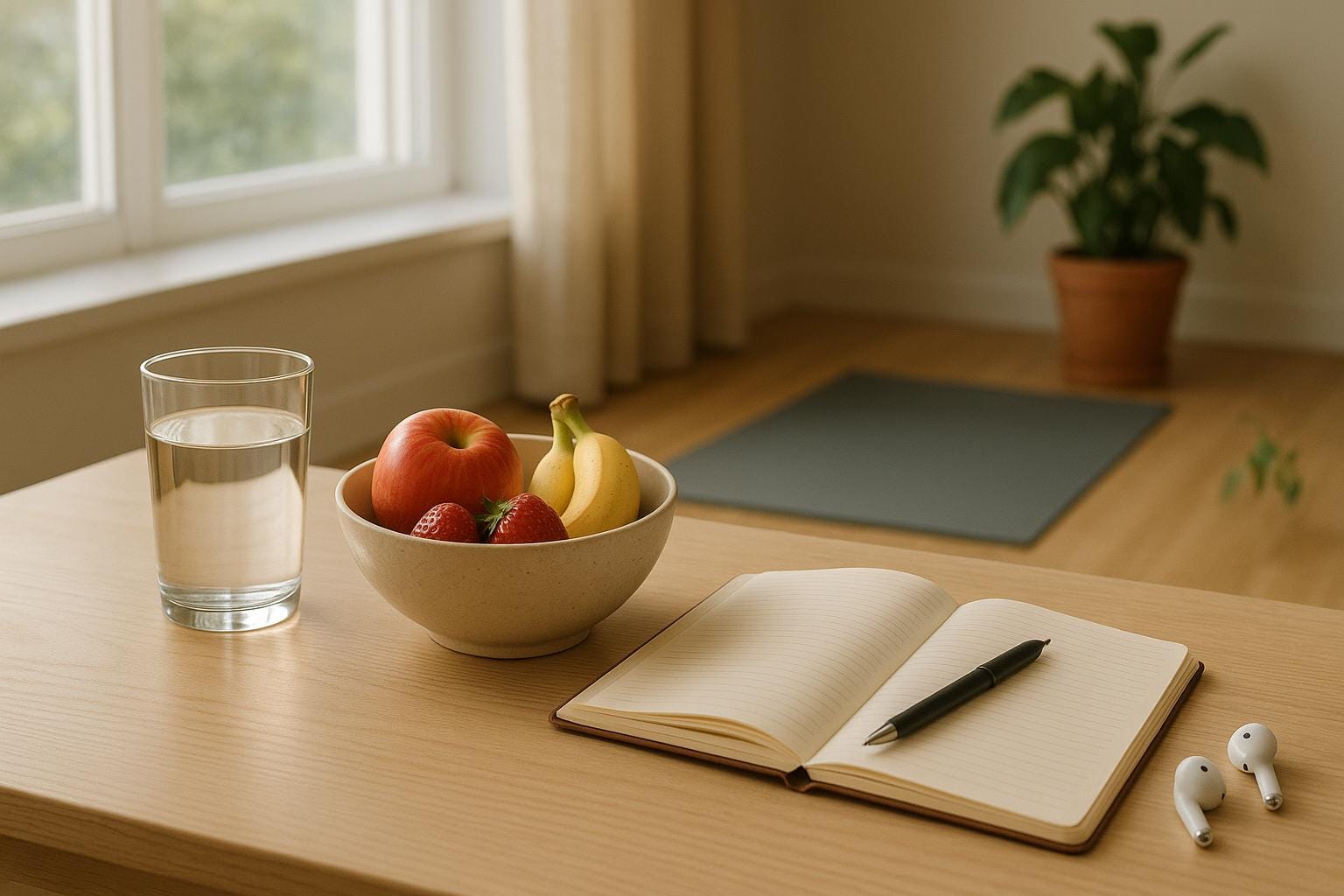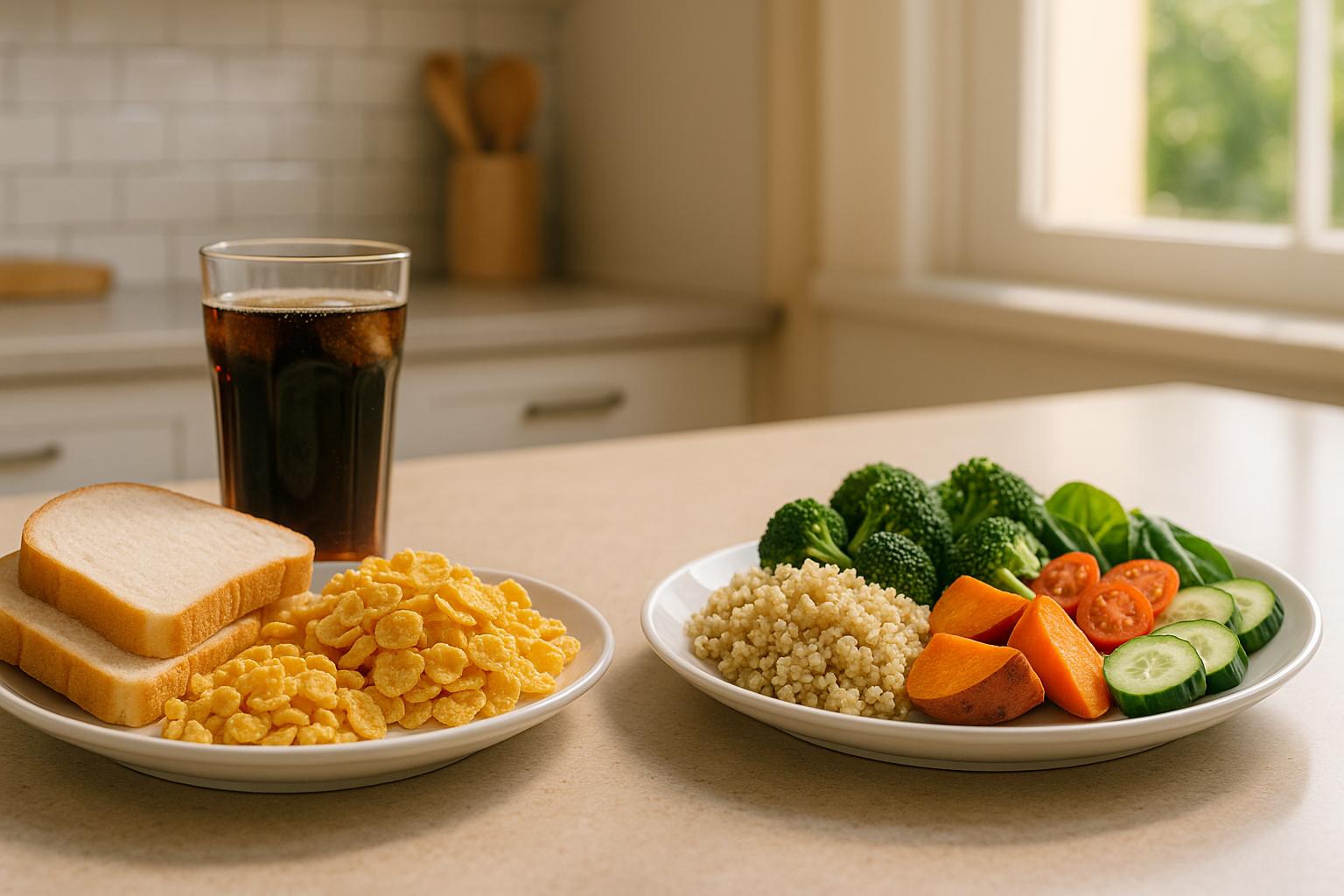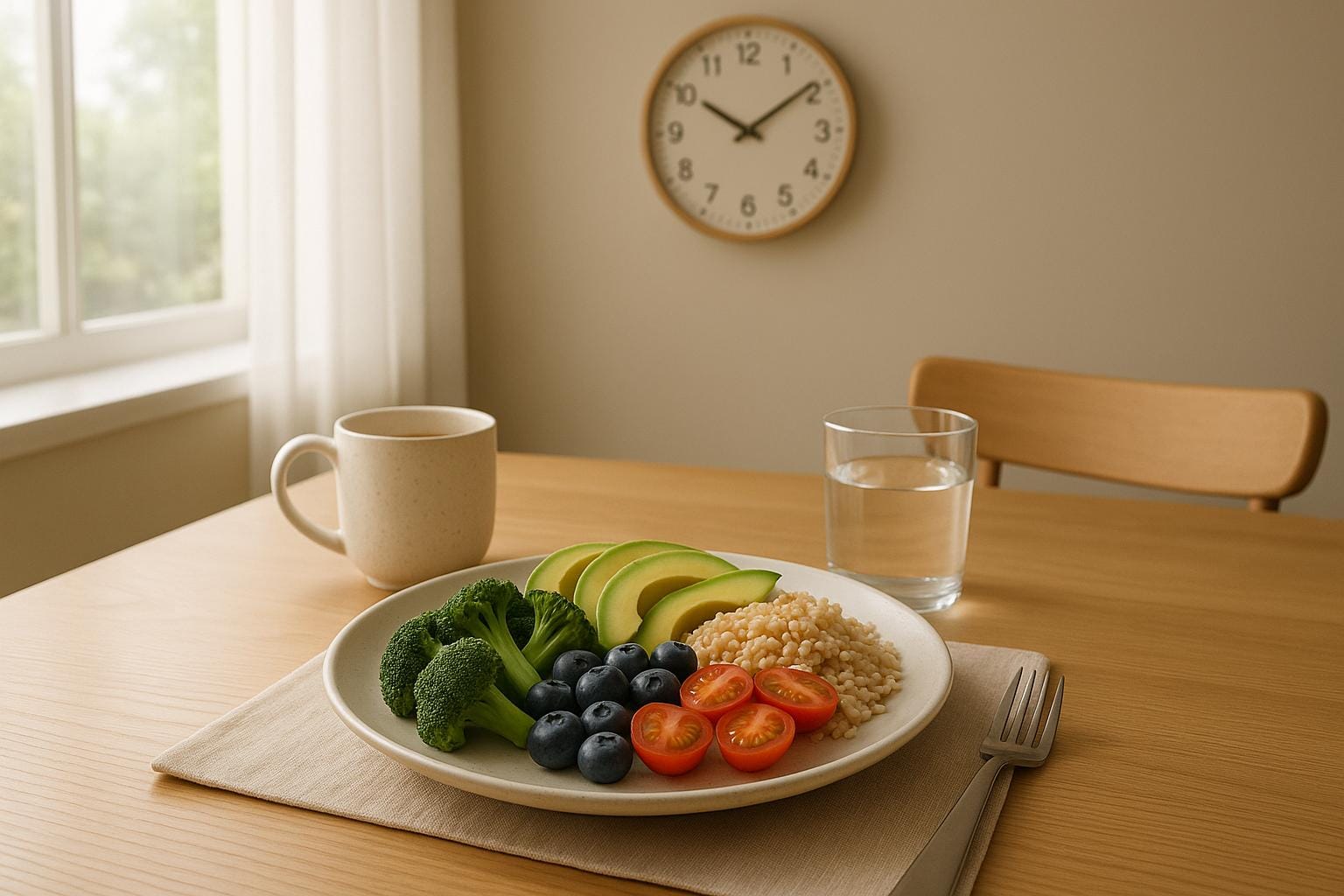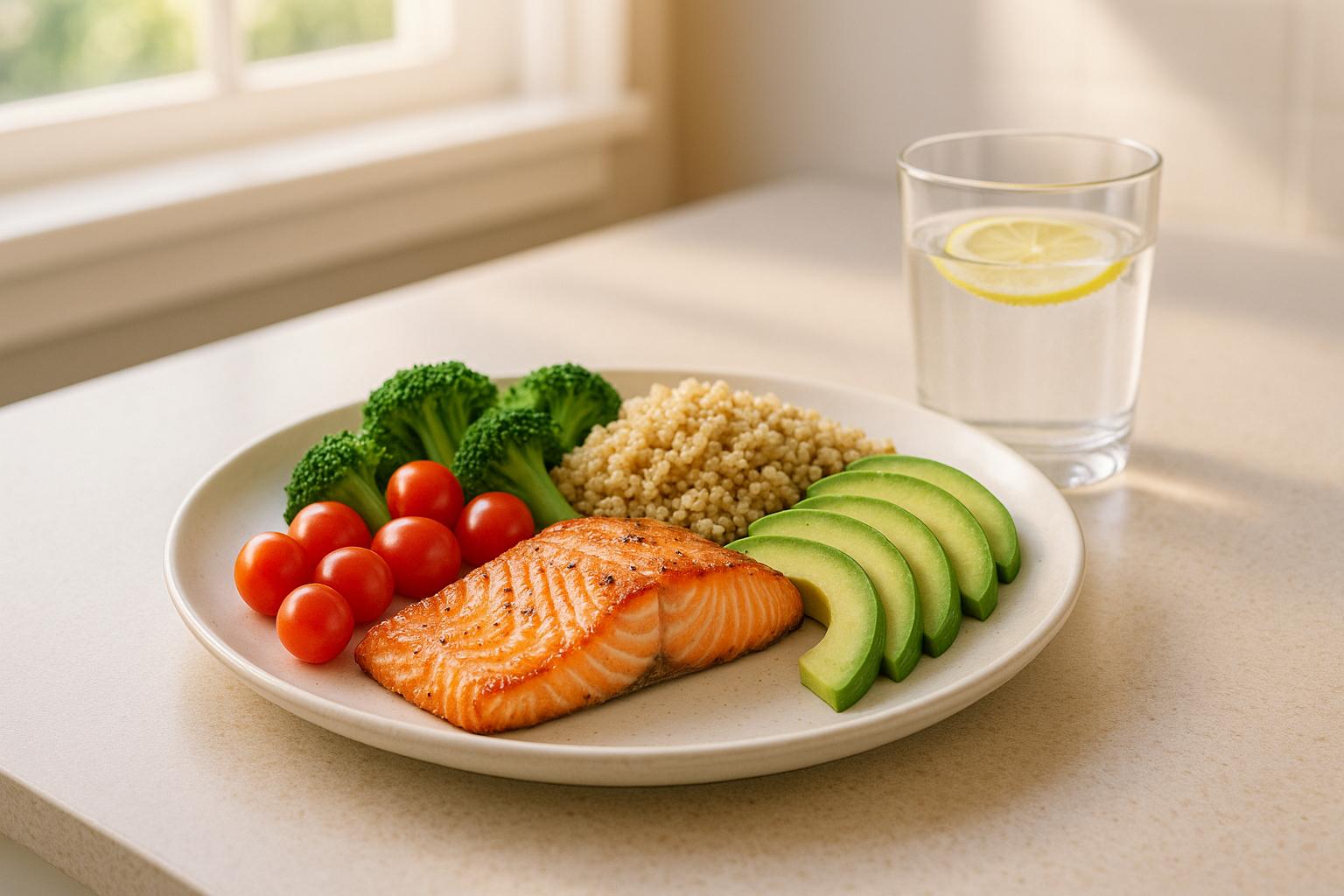Struggling to stay healthy with a packed schedule? Here’s how you can build a simple, effective routine that fits into your day:
- Plan Ahead: Dedicate 30 minutes each week to schedule meals, workouts, and rest.
- Exercise in Small Chunks: Try 5–10-minute workouts or short walks during breaks.
- Eat Smart: Prep quick, nutritious meals and keep healthy snacks handy.
- Prioritize Sleep: Stick to consistent sleep times and limit screen use before bed.
- Manage Stress: Use simple techniques like box breathing, desk yoga, or mini-meditations.
- Build Habits Gradually: Start small - add one new habit at a time and tie it to daily routines like your morning coffee.
Quick Overview:
| Focus Area | Action Steps |
|---|---|
| Exercise | 10-minute workouts, schedule workouts |
| Nutrition | Prep meals/snacks, stay hydrated |
| Mental Health | Practice mindfulness, manage stress |
| Sleep | Consistent bedtime, reduce screens |
Consistency is key - small, regular efforts lead to long-term results. Start today with just one change!
BUSY LIFESTYLE HACKS | healthy living tips for busy people
Step 1: Plan Your Week
Building a healthy routine starts with thoughtful planning. Set aside 30 minutes each Sunday to organize your health-focused activities for the week.
Schedule Meals and Exercise
Planning meals and workouts ahead of time can help you avoid the "too busy to stay healthy" trap. Treat these as essential appointments and block out specific times for them.
Mornings often work well for exercise since interruptions are less likely. Even short sessions can make a difference.
Here’s a sample weekly schedule to get you started:
| Time Block | Activity | Duration |
|---|---|---|
| 6:00 AM - 6:30 AM | Morning Workout | 30 mins |
| 7:30 AM | Breakfast | 15 mins |
| 12:30 PM | Lunch Break Walk | 15 mins |
| 6:30 PM | Dinner | 30 mins |
| 9:00 PM | Light Stretching | 10 mins |
On Sundays, prep your meals to save time during the week. For example, chop vegetables, portion out proteins, and store everything in the fridge or freezer. This keeps your meals healthy and less stressful to prepare.
Once your schedule is set, the next step is to define specific goals to stay on track.
Set Clear, Achievable Goals
Now that your week is planned, focus on setting measurable health goals to keep yourself motivated.
Here are some simple goals to start with:
- Morning Movement: Add a 10-minute yoga or stretching session to your morning routine.
- Meal Timing: Schedule three balanced meals at roughly the same times each day.
- Activity Goals: Identify specific, measurable exercise targets that work with your schedule.
- Sleep Routine: Set consistent times for going to bed and waking up.
Track your progress using realistic metrics. For instance, aim to complete most of your planned workouts rather than striving for perfection. This approach keeps you motivated while allowing for flexibility when life throws you a curveball.
Consistency is key. If you miss a workout or a planned meal, don’t sweat it - just pick up where you left off and keep going.
Step 2: Make Time for Exercise
Now that your week is planned, it’s time to fit exercise into your schedule. Quick, efficient workouts can help you stay in shape even when life gets hectic. Just like meal planning keeps your nutrition on track, short and focused workouts can help you maintain your fitness goals.
5–10 Minute Workouts
Short workouts throughout the day can add up to real health benefits. Here are some simple routines you can do almost anywhere:
Morning Energy Boost (5 minutes):
- 20 jumping jacks
- 10 pushups
- 30-second plank
- 10 bodyweight squats
- 5 burpees
Desk Break Routine (5 minutes):
- Chair squats
- Desk pushups
- Standing calf raises
- Seated core twists
- Shoulder rolls
Try to fit in 2–3 of these short sessions daily and set reminders on your phone or calendar to keep you on track.
Effective 30-Minute Workouts
For longer sessions, alternate between strength training and high-intensity interval training (HIIT) to maximize results.
HIIT Workout Example:
| Time | Activity | Intensity |
|---|---|---|
| 0–5 min | Dynamic warm-up | Light |
| 5–20 min | Circuit training | High |
| 20–25 min | Strength work | Moderate |
| 25–30 min | Cool-down | Light |
Strength Training Routine
Focus on compound exercises that target multiple muscle groups. Perform 3 sets of 8–12 reps for each:
- Squats with dumbbells
- Push-ups or bench press
- Bent-over rows
- Lunges with weights
- Planks
Cardio HIIT
Work hard for 30 seconds, then rest for 30 seconds. Repeat with these moves:
- Mountain climbers
- High knees
- Burpees
- Jump rope
- Speed skaters
Tips for Success:
- Lay out your workout clothes the night before.
- Schedule workouts during times when you feel most energetic, and have a backup time slot in case plans change.
- Track your progress to stay motivated and accountable.
Remember, consistency is key. Regular 10-minute workouts are more effective than an occasional hour-long session.
This article is for informational purposes only and not intended as medical advice. Always consult a healthcare professional before starting a new fitness routine.
Step 3: Eat Well on a Tight Schedule
Even on your busiest days, eating healthy doesn't have to be complicated. A little planning can go a long way.
Quick and Nutritious Meals
Keep it simple by prepping ingredients in advance. Stock your kitchen with essentials like whole grains, legumes, canned proteins, and pre-chopped fruits and vegetables. With these staples on hand, you can whip up quick meals that fuel your day.
Snacks That Travel Well
When you're on the go, portable snacks can help you avoid unhealthy choices. Try these easy options:
- A small handful of mixed nuts or seeds
- Cheese paired with slices of apple or pear
- Single-serving Greek yogurt cups
- Whole grain crackers with a packet of nut butter
To make life easier, pre-portion these snacks and stash them in your desk, car, or bag. And don’t forget to carry a reusable water bottle to stay hydrated throughout the day.
This article is for informational purposes only and is not intended as medical advice. Always consult a healthcare professional before making significant changes to your diet or wellness routine.
Step 4: Make Time for Mental Health
Taking care of your mental health is just as important as tackling your daily tasks. Incorporate these simple practices into your routine to maintain balance.
Improve Sleep Patterns
Getting enough sleep is essential for mental well-being. Here are two easy ways to enhance your sleep:
- Stick to a consistent bedtime and wake-up time - even on weekends.
- Reduce screen time and dim the lights at least an hour before bed to signal your body it's time to wind down.
Pairing good sleep habits with stress management techniques can help keep your mind in check.
Easy Stress-Busting Techniques
When stress builds up, try these quick methods to reset and refocus:
Box Breathing: A simple breathing exercise to calm your mind. Breathe in for 4 counts, hold for 4, exhale for 4, and pause for 4. Repeat as needed.
Desk Yoga: Stay active even while working. Try these moves:
- Neck rolls: Slowly roll your neck for 30 seconds.
- Shoulder shrugs: Lift and drop your shoulders 10 times.
- Seated twists: Twist gently to each side, holding for 15 seconds.
- Wrist and ankle rotations: Make 10 circles in each direction.
Mini-Meditation: Use short breaks - like coffee time, waiting for a meeting, or during your commute - to meditate. Even a few deep breaths can help you reset and regain focus.
Here’s a quick guide to match your time with stress relief activities:
| Time Available | Stress Relief Activity | Benefit |
|---|---|---|
| 1 minute | Box breathing | Instant calm |
| 5 minutes | Guided meditation | Improved clarity |
| 10 minutes | Quick yoga sequence | Energy boost |
Incorporating these mental health practices into your day can help you feel more grounded and productive.
Note: This article is for informational purposes only. Always consult a healthcare professional before starting any new wellness or fitness routine.
Step 5: Build Long-Term Habits
Tie New Habits to Your Daily Routine
Creating lasting health routines works best when you link new habits to activities you already do every day. This approach, often called habit stacking, helps make healthier choices feel natural.
Start by identifying regular activities that happen at consistent times - your "anchor points." These might include:
- Morning coffee or tea
- Your daily commute
- Lunch break
- Evening relaxation time
Attach a simple healthy action to these activities. For example, while waiting for your coffee to brew, spend 3-5 minutes stretching or doing yoga. This turns otherwise idle moments into opportunities for movement.
Here’s a quick guide to pairing daily tasks with healthy habits:
| Daily Activity | Healthy Habit | Time Needed |
|---|---|---|
| Morning bathroom routine | Do 5 squats while brushing teeth | 2 minutes |
| Coffee/tea prep | Simple stretching routine | 3-5 minutes |
| Work breaks | Take a short walk | 5-10 minutes |
| Evening TV time | Use light weights during ads | 2-3 minutes per break |
Once you’ve added these habits to your routine, focus on reinforcing them with additional support.
Build a Support System and Stay Motivated
Having support and accountability can make it much easier to stick with new habits. Surround yourself with people or tools that help keep you on track.
Team Up
- Find a coworker to join you for lunchtime walks.
- Get a family member to exercise with you in the evening.
- Partner with a friend for weekly meal prep sessions.
Use Technology to Your Advantage
Set reminders on your phone to align with your daily schedule. For example:
- 10:00 AM: Stand up and stretch.
- 12:30 PM: Take a short walk during lunch.
- 3:00 PM: Grab a healthy snack.
- 8:00 PM: Time for your evening relaxation routine.
Make It a Group Effort
Turn solo activities into social ones. For instance:
- Suggest walking meetings with coworkers.
- Join a weekend hiking or fitness group.
- Swap healthy recipes with friends.
- Organize a family fitness challenge.
These strategies work alongside your exercise plans, healthy eating habits, and stress management efforts to create a well-rounded approach to wellness.
Remember, consistency matters more than perfection. If you miss a day, pick up where you left off and celebrate even the small victories.
This article is for informational purposes only and is not intended as medical advice. Please consult a healthcare professional before starting any new fitness or wellness routine.
Next Steps
Now that you have a plan to incorporate healthy habits into your busy life, start small. Focus on just one or two changes to get the ball rolling.
Here’s a simple way to begin:
| Time Frame | Focus Area | Action Steps |
|---|---|---|
| Week 1-2 | Morning Routine | Add 5-10 minutes of stretching or quick exercises. |
| Week 3-4 | Meal Planning | Prep healthy snacks ahead of time. |
| Week 5-6 | Exercise | Schedule two 30-minute workout sessions. |
| Week 7-8 | Mental Health | Dedicate 5 minutes daily to mindfulness. |
The key is to take it slow - focus on mastering one habit before moving on to the next.
If you find yourself struggling, don’t hesitate to revisit and tweak your plan. Tracking your progress - whether in a journal or with an app - can help you celebrate small victories and identify areas to improve.
Remember, patience is crucial. Small, consistent steps lead to lasting change. Aim for progress, not perfection, and know that even minor adjustments can have a big impact over time.
This article is for informational purposes only and does not replace medical advice. Always consult a healthcare professional before starting any new fitness or wellness routine.
FAQs
How can I fit quick workouts into my busy daily schedule without throwing off my routine?
Incorporating short workouts into a packed schedule is easier than you might think. Start by identifying small pockets of free time, such as early mornings, lunch breaks, or evenings. Even 10–15 minutes of exercise can make a difference in boosting your health and energy levels.
Focus on efficient, high-impact exercises like bodyweight circuits, brisk walking, or stretching routines. These can be done at home or in a small space without special equipment. Consider setting reminders or blocking time on your calendar to make workouts a non-negotiable part of your day. Consistency is key - over time, these small efforts will add up to big results!
How can I maintain healthy eating habits when I don’t have much time to cook?
Maintaining healthy eating habits on a busy schedule is possible with a few simple strategies. Meal prepping can save time and ensure you have nutritious options ready to go - set aside a couple of hours each week to prepare meals or snacks in advance. Focus on versatile ingredients like grilled chicken, roasted vegetables, and cooked grains that can be mixed and matched.
When cooking isn’t an option, choose quick, healthy options like pre-washed salad mixes, frozen vegetables, or ready-to-eat protein sources like hard-boiled eggs or Greek yogurt. Keep healthy snacks like nuts, fruit, or trail mix on hand to avoid reaching for less nutritious choices. Small changes like these can make a big difference, even with a packed schedule.
How can I stick to healthy habits when my schedule is unpredictable?
Building healthy habits with a busy, ever-changing schedule can be challenging, but it’s absolutely possible with the right strategies. Start by identifying small, manageable actions you can incorporate into your day, such as a 10-minute walk, a quick meditation session, or preparing a healthy snack the night before. Focus on consistency rather than perfection - doing something small every day is more effective than aiming for an unrealistic routine.
To stay flexible, create a list of go-to habits that can fit into different time frames. For example, if you only have 5 minutes, do a quick stretch; if you have 30 minutes, squeeze in a workout or meal prep. By adapting your habits to your schedule, you’ll maintain progress even on hectic days. Remember, the key is to prioritize your well-being without overwhelming yourself.












